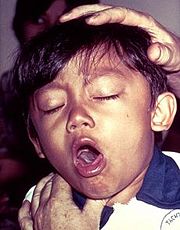Pertussis Toxin-ATP Complex
From Proteopedia
(Difference between revisions)
| Line 12: | Line 12: | ||
==Mechanism of pathogenesis== | ==Mechanism of pathogenesis== | ||
Following the pertussis toxin binding to the cell membrane, the toxin is taken up by an endosome and transported from the plasma membrane via the Golgi apparatus to the endoplasmic reticulum (ER) where finally membrane translocation occurs. The destabilization of PT occurs in the ER prior to membrane translocation. After binding of ATP, cleavage of the single disulphide bond in subunit S1 <scene name='Pertussis_Toxin-ATP_Complex/Disulphide_bonds_breaking/1'>(Cys 41-Cys 201)</scene> is believed to trigger a conformational change necessary to expose the active site to its substrates. The reducation step takes place after interaction of PT with ATP. After destabilization, the S1 becomes active and catalyzes the ADP-ribosylation of the alpa-subunit of regulatory trimeric G-proteins (Gialpha). This then prevents Gialpha from inhibiting adenylate cyclase and leads to an increase in intracellular levels of cyclic AMP (cAMP). The increase in cAMP affects normal biological signaling and causes severe effects such as hypoglycemia. | Following the pertussis toxin binding to the cell membrane, the toxin is taken up by an endosome and transported from the plasma membrane via the Golgi apparatus to the endoplasmic reticulum (ER) where finally membrane translocation occurs. The destabilization of PT occurs in the ER prior to membrane translocation. After binding of ATP, cleavage of the single disulphide bond in subunit S1 <scene name='Pertussis_Toxin-ATP_Complex/Disulphide_bonds_breaking/1'>(Cys 41-Cys 201)</scene> is believed to trigger a conformational change necessary to expose the active site to its substrates. The reducation step takes place after interaction of PT with ATP. After destabilization, the S1 becomes active and catalyzes the ADP-ribosylation of the alpa-subunit of regulatory trimeric G-proteins (Gialpha). This then prevents Gialpha from inhibiting adenylate cyclase and leads to an increase in intracellular levels of cyclic AMP (cAMP). The increase in cAMP affects normal biological signaling and causes severe effects such as hypoglycemia. | ||
| + | |||
| + | ==Treatment== | ||
==Conclusion== | ==Conclusion== | ||
Revision as of 20:17, 9 November 2011
| |||||||||||
References
- ↑ Hazes B, Boodhoo A, Cockle SA, Read RJ. Crystal structure of the pertussis toxin-ATP complex: a molecular sensor. J Mol Biol. 1996 May 17;258(4):661-71. PMID:8637000 doi:10.1006/jmbi.1996.0277

